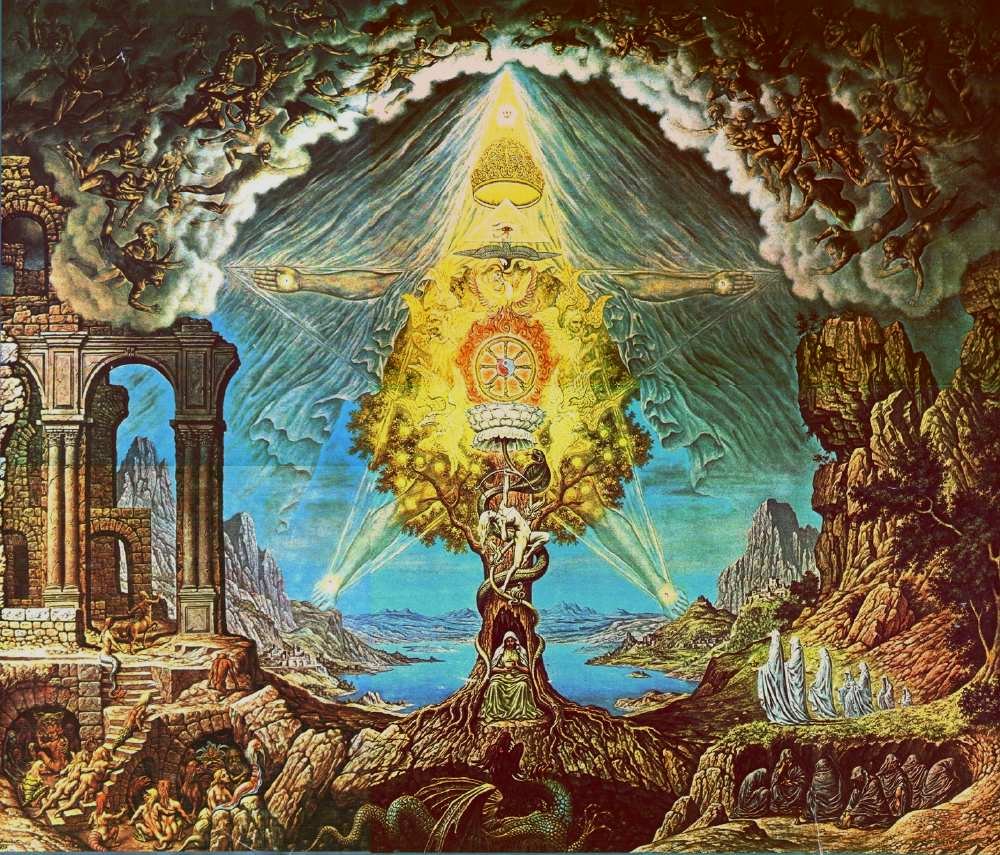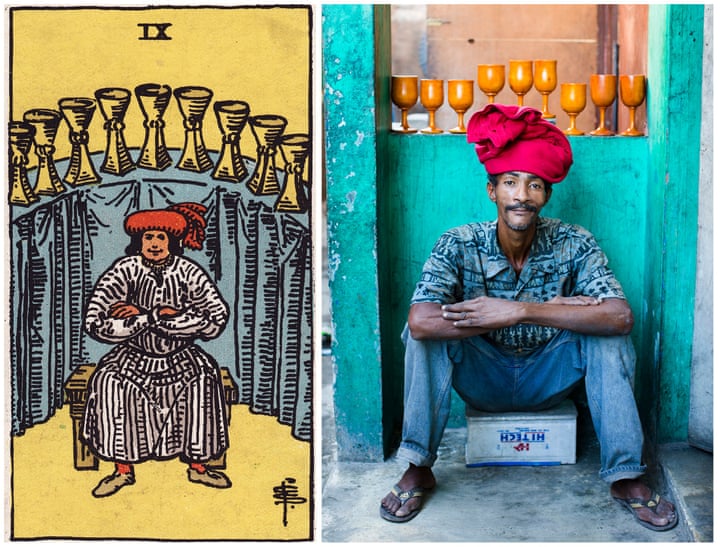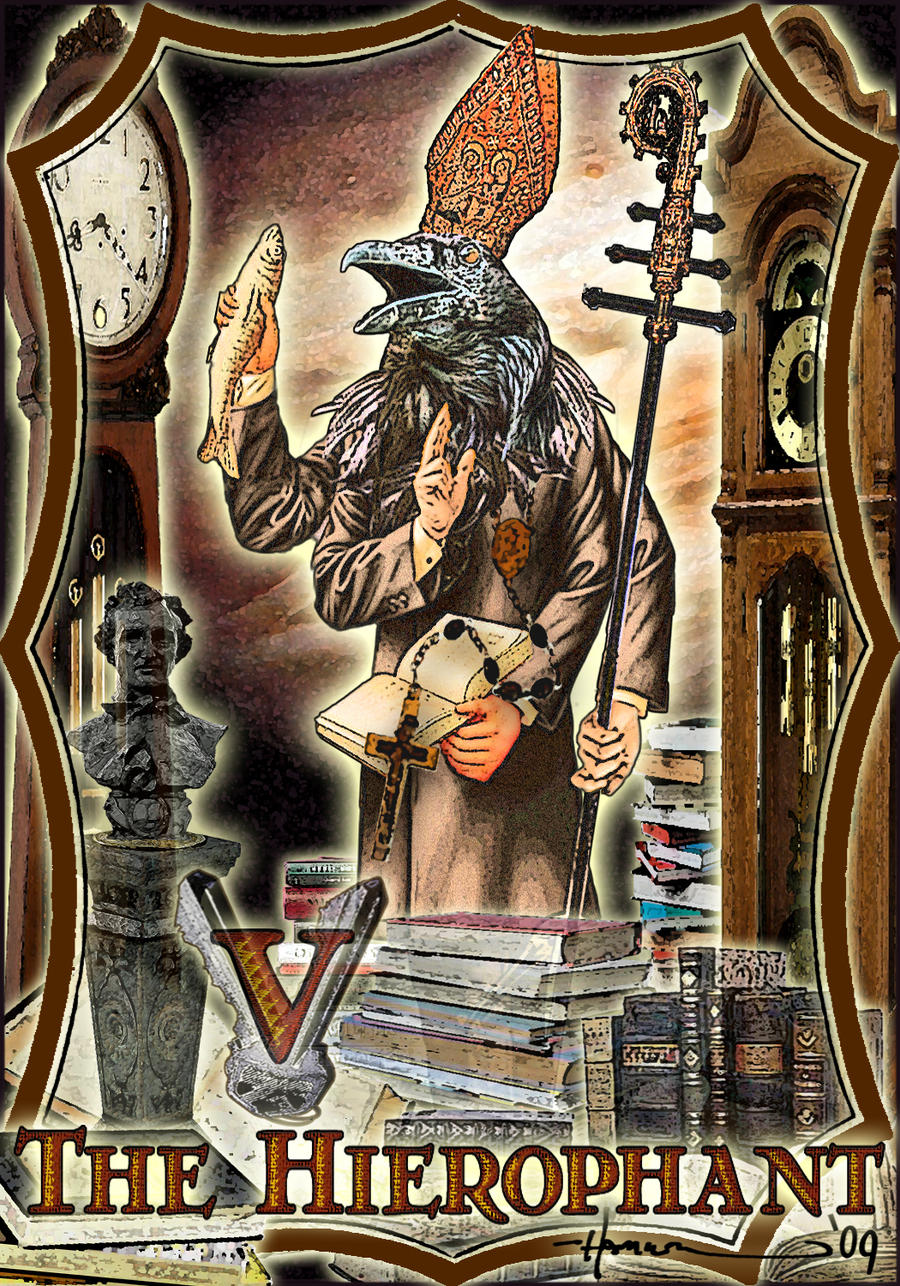I discussed in my previous post how I want religion to be relatable (yet weird) and meaningful. I'm still trying to articulate to myself why I think the Greyhawk-esque deity spread is so boring (because the choices flow from mechanical advantage instead of what you think would be most interesting?); but more importantly, I want to "fix" it. Sure, you can be a critic, but it's somewhat unhelpful for me to just say "I don't like this" without saying "...but I
do like this."
Fair Warning: For this post, I'm going to be talking generally about the implied setting of my current game. I say implied because most of the setting is given to the players by the rules and fluff text. Rarely do I put in big chunks of prose or exposition.
As mentioned previously, the Cult of Mythrys is important because they are a political organization. They are an
institution. The faith is one of the four estates in the social order of the City. They are represented by the suit of cups. They are the scribes, the money-changers, the physicks, the apothecaries, the lore-masters, the historians, the lawyers. They're important to have around.
Touchstones
What is the Cult like, though? What's it like to be a member? What do they believe?
Alright, full disclosure here--I have a background in LARPing. I wrote and ran a small game for about seven years. There's something I really like about LARPs that I haven't found necessarily true for the tabletop community: the character-facing fluff is written in a way to
make you think about your character. Often, tabletop RPGs write fluff to worldbuild. It could be interesting or a good story, but the author is rarely writing with the intention of saying "how" your character acts. The writing doesn't facilitate conversations about that subject.
In well-written LARPs, however, authors stuff cool character traits, cultural habits, ticks, and beliefs into character-facing material. The Ultek consider it vulgar to touch hands, since hands are the agents of their will. Elves do not share their food with mortals. Albionish are deferential to women, and the flowers they wear mean different things about their relationship status. Grueth barbarians consider it a great dishonor to see your back, and will attack it to prove that they are not someone to go unwatched. The Green Elves consider it a great shame to have a magic spell cast on them.
These little details
mean something in the game, and boy do they come up. You put weird little cultural gimmicks into the different character choices a player can make, and you're adding chemically reactive ingredients into a potion and shaking it up. Characters conflict. Cultural shock happens. Players are forced to make hard choices about how their character feels about attacking a woman (shock) who is unarmed (double shock) but also possessed and wielding necromantic energies (triple shock!) without concern for herself or others. You have a sword in your hand, but are you willing to kill an innocent woman to stop the demon inside's rampage? If you do so, doesn't it mean dishonor and disbarment from your order of knighthood? I've seen great, meaningful moments of roleplay come out of these situations.
To try and facilitate the discussion of culture without being prescriptivist about setting or your character, I use touchstones. Touchstones raise questions, but don't necessarily answer them. Or they give you a generic idea and beg you to explore the specifics.
These Things are Mysteries
The Cult of Mythrys is a mystery cult. Its teachings are secrets. The uninitiated may not know--must not know--the truths hinted at and obscured by layers of metaphor, parable, and symbolism. Indeed, it is many tiered. The adherents of higher levels know more sacred secrets than those of lower levels. A monk may spend his entire life pursuing the deeper truths of Mythrys and never gain the true enlightenment of the deepest initiations.
- A Mythric religious ceremony or religious text is begun and ended with the phrase: "These things are mysteries."
- A member of the cult is called a mystai, which means "initiate." Someone non-initiated is called a stulte, which means "fool."
- The Cult still considers the non-initiated to be "in" the Cult; they just rank 0.
- There are twenty-one ranks of initiation which mystai advance through in their religious career.
- If you are in the cult, you are probably rank 1. Your local clergyman is probably rank 4 or 5. Monks and nuns are around level 7-14. Bishops and cardinals occupy the ranks 15+.
- It's hard for adventurers to advance in initiation grades. To unlock deeper mysteries, you need to do things like spend a year in silent contemplation, or perform great feats of bodily mutilation, or do a pilgrimage. Things that get in the way of adventuring.
- Large donations to the Cult sometimes fit this bill.
- Only the Secret Pope has achieved the greatest initiation: the twenty-first rank. He learns the secrets of this initiation directly from the last pope.

God in One-Thousand Persons, Blessed Multiplicity
The essential gimmick of Mythrys is this: god is many and is also one. He is a contradiction. As mystai advance in ranks, they are told a different story about who or what god is. They believe these stories with utter conviction until they advance to the next rank and have to unlearn what they have learned.
The thousand-faced god is called the
Monad, which means "alone." He created everything. He created orders of angelic beings to serve him and sub-create his creation. The greatest of these is a dragon named
Demiurge, which means "crafter." It's commonly accepted that Demiurge did a bad job at this, and that's why there's earthquakes and locusts.
- Each rank in the cult has a view of the Monad that corresponds to the major arcana in the Tarot.
- Therefore, rank 1 mystai believe that God is essentially a magician.
- Rank 2 mystai believe that God is unable to be worshipped, but they revere Maiden Wisdom (see below) and call her the High Priestess.
- Rank 3 mystai believe that Maiden Wisdom is actually God(dess), and call Her the Empress.
- Rank 4 mystai realize that no, God is male after all and call him the Emperor.
- Etc.
- Mystai believe different things and have essentially different worldviews as they advance in their religious orders.
- One might believe in reincarnation, the other in a end-of-days resurrection, and a third in the extinction of the soul upon death. They might all agree that the Apocalypse is soon at hand, whereas a more senior member of the Cult believes that the Apocalypse is a heresy.
Hail Wisdom, Mother of Misery, Monad is With Thee /
Hail Mythrys, Servant of Monad, May You Find Peace
The human face of the Monad is the prophet Mythrys and his mother Maiden Wisdom. There are lots of stories about Mythrys and Maiden Wisdom, most of which are difficult to rationalize. They say that Mythrys was born of a maiden, but also that he was born of a stone--there are some complicated narratives that attempt to make both work. They say that he slew the animals of the zodiac and placed them in the sky. They say that Mythrys died and rose again from the dead. They say that Mythrys now feasts with the Sun in the palaces of Heaven.
It was Mythrys who first initiated men into the sacred mysteries. He had twenty disciples. He taught them each different sacred truths. When he departed from the world of flesh, the twenty-first disciple, a mere child of six, revealed that he was the Secret Pope and became the head of the Cult.
The Cult of Mythrys exists in a
Grecian Mystery Cult slash
Levant religiosity pastiche. The actual texts and stories used by the Cult don't matter. Players don't have to memorize stuff like that. Players should feel free to make up parables in this mode to serve their own purposes and further flesh out the religious canon of the Cult.
Take Aways
OK. Well. How does that feel? I admit, I like having this vague-yet-defined set up for religions more than quietly feeling dubious that religion in a world where clerics can Create Water would have any problem collecting followers. I like drawing an outline and letting players color in the spaces (Draw Maps, Leave Spaces, as Dungeon World says). I like this mishmash of ideas.
Stats? Still none. I have a vague idea that religions can probably be used to shove in "optional rules," but I'm leery of mechanics taking advantage over "what is cool" when it comes to faith. I sort of like worshipers of the god of chaos having to deal with the sting of critical failures and the thrill of critical successes, though. I sort of like alignment being a social construct instead of a metaphysical one. We'll see.
By the way, check out Ten Foot Polemic's Religion Writeup
here and
here if you want to see some religious tom-foolery that far surpasses anything that dribbles out of my mouth.




